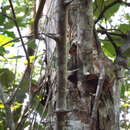en
names in breadcrumbs


Havardia albicans is a perennial tree of the family Fabaceae that grows to 5 meters tall. It is native to Mexico, the Caribbean and Central America, in regions around the Yucatan Peninsula. Common names for it include chucum and cuisache.[1] It is reputed to be psychoactive.[2] Its sap can be boiled and added to plaster to make waterproof stucco, and this may explain the longevity of Mayan plaster.[3]
Junior synonyms are:[1]
Havardia albicans is a perennial tree of the family Fabaceae that grows to 5 meters tall. It is native to Mexico, the Caribbean and Central America, in regions around the Yucatan Peninsula. Common names for it include chucum and cuisache. It is reputed to be psychoactive. Its sap can be boiled and added to plaster to make waterproof stucco, and this may explain the longevity of Mayan plaster.
Junior synonyms are:
Acacia albicans Kunth Albizia lundellii Standl. Albizia rubiginosa Standl. Feuilleea albicans (Kunth) Kuntze Pithecellobium albicans (Kunth) Benth. Pithecolobium albicans (Kunth) Benth. (lapsus)